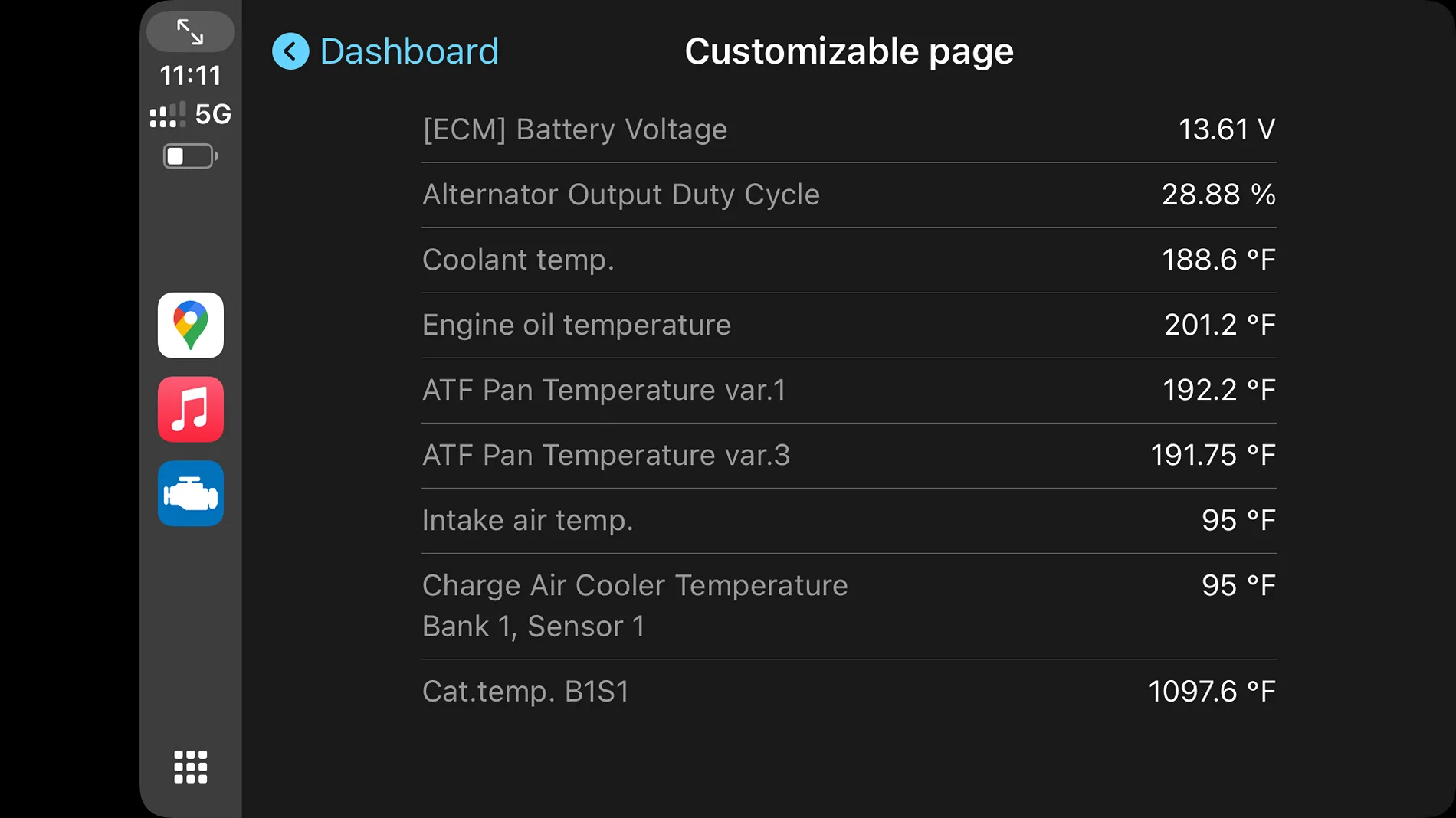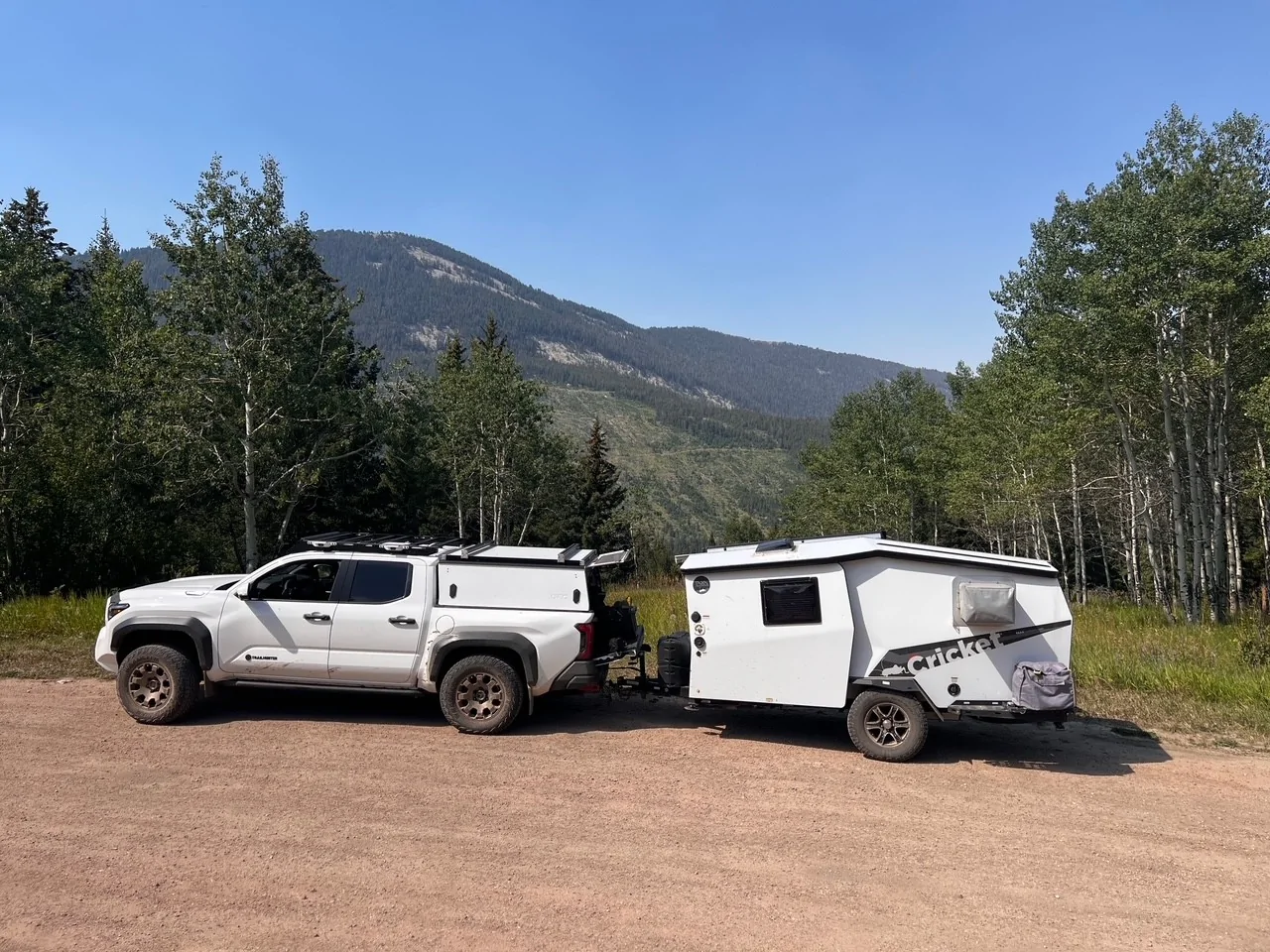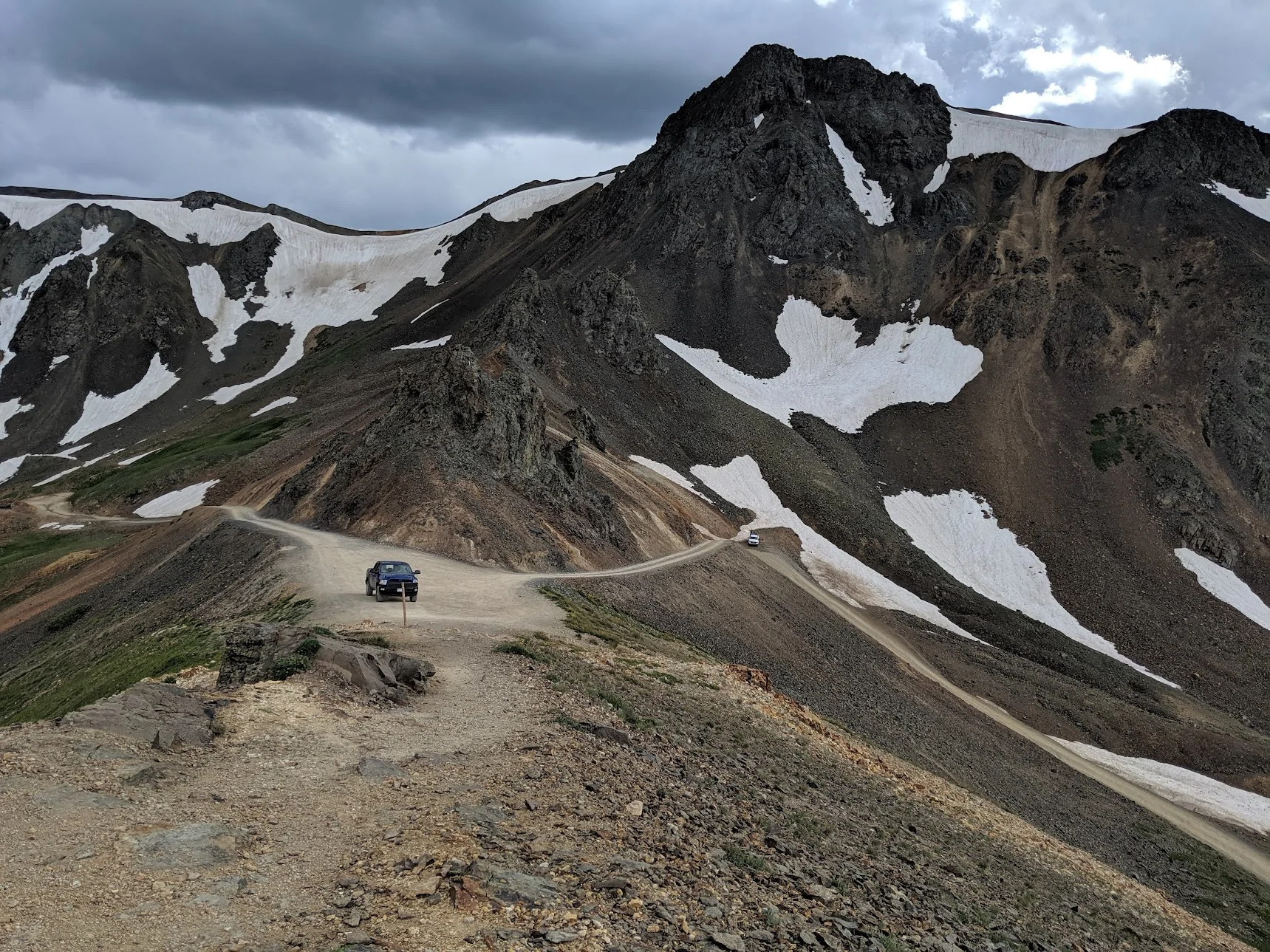- First Name
- Jake
- Joined
- Apr 29, 2025
- Threads
- 0
- Messages
- 24
- Reaction score
- 26
- Location
- Sacramento CA
- Vehicle(s)
- 2024 Tacoma Off Road Premium
This sounds awesome. Can you post a picture of your screen with all the data on it.

Sponsored
This sounds awesome. Can you post a picture of your screen with all the data on it.


I think you're right, also the torque converter (source of majority of AT heat) is more likely to be locked the higher your RPMs are. Once its locked up the heat production will pretty much disappear, which is probably happening in 4Lo or higher RPM in 4Hi.keep the RPMs around 1900-2300 stopped the temp climb
So the idea is that we use the manual gear selector, keep it in a lower gear with higher RPMs on long 4wd climbs. It’s funny because I typically would avoid that to avoid overheating the engine. I will go test my climb spot again redlining 2nd gear and see what happens.I think you're right, also the torque converter (source of majority of AT heat) is more likely to be locked the higher your RPMs are. Once its locked up the heat production will pretty much disappear, which is probably happening in 4Lo or higher RPM in 4Hi.
Let me paint a picture for you, which might provide a different perspective. Have you ever ridden a mountain bike with multiple gears? Lower gears give you lots of torque to get going, and higher gears are good for speed, but become very difficult to pedal if you find yourself slowing down on a hill, for example. The wrong gear, based on the conditions, can make all the difference. This is the ratio of pedal turns (crank) versus wheel turns.So the idea is that we use the manual gear selector, keep it in a lower gear with higher RPMs on long 4wd climbs. It’s funny because I typically would avoid that to avoid overheating the engine. I will go test my climb spot again redlining 2nd gear and see what happens.
So the idea is that we use the manual gear selector, keep it in a lower gear with higher RPMs on long 4wd climbs. It’s funny because I typically would avoid that to avoid overheating the engine. I will go test my climb spot again redlining 2nd gear and see what happens.
@rchrds good tip on tow/haul dropping a gear. Will try that.
Let me paint a picture for you, which might provide a different perspective. Have you ever ridden a mountain bike with multiple gears? Lower gears give you lots of torque to get going, and higher gears are good for speed, but become very difficult to pedal if you find yourself slowing down on a hill, for example. The wrong gear, based on the conditions, can make all the difference. This is the ratio of pedal turns (crank) versus wheel turns.
My google-fu isnt easily showing the drive ratios for the 2024 Tacoma 8AT, but 3rd gen specs are easily available. So I will go with that for an example. 2016 6AT 3.5L V6, 278hp/265lb-ft@4600rpm:
1st gear 3.60
2nd 2.09
3rd 1.49
4th 1.00
5th 0.69
6th 0.58
Rear end axle ratio 3.90
Multiply maximum torque (265) X Gear X Rear End = final drive output (not taking into account torque loss through transmission of up to 25% due to slippage)
1st gear 265 x 3.60 x 3.90= 3,720lb-ft of torque
2nd gear 265 x 2.09 x 3.90 =2,160lb-ft
3rd 265 x 1.49 x 3.90 = 1,539lb-ft
4th 265 x 1.00 x 3.90 = 1,034lb-ft
5th 265 x 0.69 x 3.90 = 713lb-ft
6th 265 x 0.58 x 3.90 = 599lb-ft
These numbers are higher than you would find in a real world scenario, because torque loss through the drivetrain is not accounted for, neither is power loss from elevation (thinner air), which might not be a factor due to the 4th gen turbocharger.
So, based on the above, we can make some assumptions/generalizations.
In the same situation, for example an incline, requiring 50% of engine final drive output (769lb-ft) in 3rd gear to maintain constant speed, if instead 2nd gear is chosen, the same 769lb-ft is only 35.6% of available torque in 2nd gear; higher rpm yes, but less actual load on the engine. Also, heat load is potentially greater with reduced airflow at slower off road speeds, which the vehicle may reduce power output to compensate for; reducing available torque even more.
Lastly, "redlining" as you stated, if taken literally, wont be beneficial long term. A Toyota Tacoma, great vehicle, driven moderately, proper maintenance done, will outlive you and me. That same Tacoma, driven at literal full wide open throttle at max redline rpm, will blow up in fifteen minutes or less. Needless to say, you want to keep it in the powerband that the camshaft profile was tailored to.
Hope this helps.
So for example, climbing at 3000 RPM in 2nd gear vs 3000 rpm in 3rd gear. Even though RPM is the same, there is less load on the engine in second gear. RPM is not directly linked to engine output. Thank you, that is a helpful way to visualize that. I am being a bit facetious with the red line comment. I forget there are people out there taking things literally. Manual gears should be used on just about any incline/decline. I drive steep dirt roads on a daily so I am taking a guinea pig approach to this. With the exception of my 23 Colorado Trailboss all my vehicles have been dumb old tech where gear selection was the only options. I just find it ironic that a truck with all this smart offroad tech and it still cant figure out gear selection. Not actual "redlining" but it seems like keeping the truck in 2 (to keep it from going to gears 3 and up) and pushing it a bit with the revs is better for the truck than moving up to 3rd to keep RPMS lower. It would be interesting to test a good climb in 2 vs 3 (and letting all that smart tech decide when to upshift) and see what happens. For reference - My 8000# Cummins Ram on Calfornia Pass heading over to Corkscrew. I would kill for some down hill assist on that beast because 1st gear alone doesnt do enough.Offroading in 4Lo, I am never in Drive. Downhill I downshift to engine break. Going uphilll I tend to be in 2nd to 4th Flat landing I tend to hang out in 4th or 5th. It depends on feel and rpm
Towing I just go to 5th on my 6 speed Land Cruiser Tranny. On the Tacoma, it could be 6th or 7th gear. In that situation, its about the tranny hunting for gears in D using the automated algorithm proceess. That is my experiance in a Land Cruiser, I haven't towed yet with the Tacoma but wwould assume it is similar

Coming from a 1st Gen V6, this little hybrid 4banger doesn't engine brake for shit, however, I have noticed that on long highway descents (think I-70 back into Denver) in drive, the engine will downshift one gear, and it does brake using the hybrid system (you can feel the braking, but the brake lights aren't activated.) I suspect that when you use the "brakes" while descending off road in manual, that it is also using the regenerative braking system, and I bet that it would be difficult to overheat the normal brakes with a hybrid system.Offroading in 4Lo, I am never in Drive. Downhill I downshift to engine break. Going uphilll I tend to be in 2nd to 4th Flat landing I tend to hang out in 4th or 5th. It depends on feel and rpm
Yea, I'm nowhere near redline (6Kish) I'm normally puttering along between 1800 and 2300, which seems to be the smooth mostly quiet range. If left in D, it would drop down to 1300-1500, and I think that's where we are seeing the heat issues. Remember the engine isn't overheating, the transmission is. And those lower RPMS and high torque load really heat up the transmission.So the idea is that we use the manual gear selector, keep it in a lower gear with higher RPMs on long 4wd climbs. It’s funny because I typically would avoid that to avoid overheating the engine. I will go test my climb spot again redlining 2nd gear and see what happens.
That isn't my experiance (not engine braking for s&%t), but I ihave a non Hybrid version. I have found the lower gears to be better for engine braking than in my Land Cruiser going downhill offroad. I didn't have any issues going down the mtn passes on I-70 engine braking.Coming from a 1st Gen V6, this little hybrid 4banger doesn't engine brake for shit, however, I have noticed that on long highway descents (think I-70 back into Denver) in drive, the engine will downshift one gear, and it does brake using the hybrid system (you can feel the braking, but the brake lights aren't activated.) I suspect that when you use the "brakes" while descending off road in manual, that it is also using the regenerative braking system, and I bet that it would be difficult to overheat the normal brakes with a hybrid system.
Think I killed my brakes coming off of Powder Mountain, 5 miles of average 14% grade lolThat isn't my experiance (not engine braking for s&%t), but I ihave a non Hybrid version. I have found the lower gears to be better for engine braking than in my Land Cruiser going downhill offroad. I didn't have any issues going down the mtn passes on I-70 engine braking.
That isn't my experiance (not engine braking for s&%t), but I ihave a non Hybrid version.
This is likely due to the Atkinson cycle of the hybrid (less engine braking) and regenerative braking of the hybrid system (recharging the battery).Yea, the hybrid and non-hybrid are really not comparable, they operate completely differently. Even on mild slopes, downshifting as much as two gears, the trailhunter will still accelerate beyond the gear range and automatically upshift, it has almost zero engine braking capability.
i also have a TH and it has over temp the Tranmission twice while out west in May and went into limp mode..Coming from a 1st Gen V6, this little hybrid 4banger doesn't engine brake for shit, however, I have noticed that on long highway descents (think I-70 back into Denver) in drive, the engine will downshift one gear, and it does brake using the hybrid system (you can feel the braking, but the brake lights aren't activated.) I suspect that when you use the "brakes" while descending off road in manual, that it is also using the regenerative braking system, and I bet that it would be difficult to overheat the normal brakes with a hybrid system.
Yea, I'm nowhere near redline (6Kish) I'm normally puttering along between 1800 and 2300, which seems to be the smooth mostly quiet range. If left in D, it would drop down to 1300-1500, and I think that's where we are seeing the heat issues. Remember the engine isn't overheating, the transmission is. And those lower RPMS and high torque load really heat up the transmission.
Also, I have a trailhunter, which I suspect comes with some sort of transmission cooler due to the integrated towing package. This may be why I didn't overtemp, in similar conditions to OP.